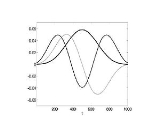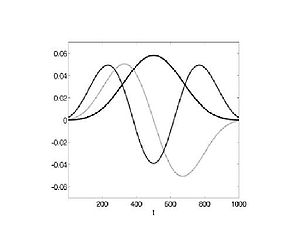
Spectral concentration problem
Encyclopedia

Discrete Fourier transform
In mathematics, the discrete Fourier transform is a specific kind of discrete transform, used in Fourier analysis. It transforms one function into another, which is called the frequency domain representation, or simply the DFT, of the original function...
is maximally localized on a given frequency
Frequency
Frequency is the number of occurrences of a repeating event per unit time. It is also referred to as temporal frequency.The period is the duration of one cycle in a repeating event, so the period is the reciprocal of the frequency...
interval, as measured by the spectral concentration.
Spectral concentration
The discrete-time Fourier transformDiscrete-time Fourier transform
In mathematics, the discrete-time Fourier transform is one of the specific forms of Fourier analysis. As such, it transforms one function into another, which is called the frequency domain representation, or simply the "DTFT", of the original function . But the DTFT requires an input function...
(DTFT) U(f) of a finite series
 ,
,  is defined as
is defined as
In the following, the sampling interval will be taken as Δt = 1, and hence the frequency interval as
f ∈ [-½,½]. U(f) is a periodic function
Periodic function
In mathematics, a periodic function is a function that repeats its values in regular intervals or periods. The most important examples are the trigonometric functions, which repeat over intervals of length 2π radians. Periodic functions are used throughout science to describe oscillations,...
with a period 1.
For a given frequency W such that 0<W<½, the spectral concentration
 of U(f) on the interval [-W,W] is defined as the ratio of power of U(f) contained in the frequency band [-W,W] to the power of U(f) contained in the entire frequency band [-½,½]. That is,
of U(f) on the interval [-W,W] is defined as the ratio of power of U(f) contained in the frequency band [-W,W] to the power of U(f) contained in the entire frequency band [-½,½]. That is,
It can be shown that U(f) has only isolated zeros and hence
 (see [1]). Thus, the spectral concentration is strictly less than one, and there is no finite sequence
(see [1]). Thus, the spectral concentration is strictly less than one, and there is no finite sequence  for which the DTFT can be confined to a band [-W,W] and made to vanish outside this band.
for which the DTFT can be confined to a band [-W,W] and made to vanish outside this band.Statement of the problem
Among all sequencesSéquences
Séquences is a French-language film magazine originally published in Montreal, Quebec by the Commission des ciné-clubs du Centre catholique du cinéma de Montréal, a Roman Catholic film society. Founded in 1955, the publication was edited for forty years by Léo Bonneville, a member of the Clerics...
 for a given T and W, is there a sequence for which the spectral concentration is maximum? In other words, is there a sequence for which the sidelobe energy outside a frequency band [-W,W] is minimum?
for a given T and W, is there a sequence for which the spectral concentration is maximum? In other words, is there a sequence for which the sidelobe energy outside a frequency band [-W,W] is minimum?The answer is yes; such a sequence indeed exists and can be found by optimizing
 . Thus maximising the power
. Thus maximising the power
subject to the constraint that the total power is fixed, say

leads to the following equation satisfied by the optimal sequence
 :
:
This is an eigenvalue equation for a symmetric matrix
Matrix (mathematics)
In mathematics, a matrix is a rectangular array of numbers, symbols, or expressions. The individual items in a matrix are called its elements or entries. An example of a matrix with six elements isMatrices of the same size can be added or subtracted element by element...
given by

It can be shown that this matrix is positive-definite, hence all the eigenvalues of
this matrix lie between 0 and 1. The largest eigenvalue of the above equation corresponds to the largest possible spectral concentration; the corresponding eigenvector is the required optimal sequence
 . This sequence is called a 0th–order Slepian sequence (also known as a discrete prolate spheroidal sequence, or DPSS), which is a unique taper with maximally suppressed sidelobes.
. This sequence is called a 0th–order Slepian sequence (also known as a discrete prolate spheroidal sequence, or DPSS), which is a unique taper with maximally suppressed sidelobes.It turns out that the number of dominant eigenvalues of the matrix M that are close to 1, corresponds to N=2WT called as Shannon number
Shannon number
The Shannon number, named after Claude Shannon, is an estimated lower bound on the game-tree complexity of chess. Shannon calculated it as an aside in his 1950 paper "Programming a Computer for Playing Chess"...
. If the eigenvectors
 are arranged in decreasing order (i.e,
are arranged in decreasing order (i.e,  ), then the eigenvector corresponding to
), then the eigenvector corresponding to  is called nth–order Slepian sequence (DPSS) (0≤n≤N-1). This nth–order taper also offers the best sidelobe suppression and is pairwise orthogonal to the Slepian sequences of previous orders
is called nth–order Slepian sequence (DPSS) (0≤n≤N-1). This nth–order taper also offers the best sidelobe suppression and is pairwise orthogonal to the Slepian sequences of previous orders  . These lower order Slepian sequences form
. These lower order Slepian sequences formthe basis for spectral estimation by multitaper
Multitaper
In signal processing, the multitaper method is a technique developed by David J. Thomson to estimate the power spectrum SX of a stationary ergodic finite-variance random process X, given a finite contiguous realization of X as data....
method.
Not limited to time series, the spectral concentration problem can be reformulated to apply on the surface of the sphere by using spherical harmonics
Spherical harmonics
In mathematics, spherical harmonics are the angular portion of a set of solutions to Laplace's equation. Represented in a system of spherical coordinates, Laplace's spherical harmonics Y_\ell^m are a specific set of spherical harmonics that forms an orthogonal system, first introduced by Pierre...
, for applications in geophysics
Geophysics
Geophysics is the physics of the Earth and its environment in space; also the study of the Earth using quantitative physical methods. The term geophysics sometimes refers only to the geological applications: Earth's shape; its gravitational and magnetic fields; its internal structure and...
and cosmology
Cosmology
Cosmology is the discipline that deals with the nature of the Universe as a whole. Cosmologists seek to understand the origin, evolution, structure, and ultimate fate of the Universe at large, as well as the natural laws that keep it in order...
among others.
See also
- MultitaperMultitaperIn signal processing, the multitaper method is a technique developed by David J. Thomson to estimate the power spectrum SX of a stationary ergodic finite-variance random process X, given a finite contiguous realization of X as data....
- Fourier transformFourier transformIn mathematics, Fourier analysis is a subject area which grew from the study of Fourier series. The subject began with the study of the way general functions may be represented by sums of simpler trigonometric functions...
- Discrete Fourier transformDiscrete Fourier transformIn mathematics, the discrete Fourier transform is a specific kind of discrete transform, used in Fourier analysis. It transforms one function into another, which is called the frequency domain representation, or simply the DFT, of the original function...
- Shannon numberShannon numberThe Shannon number, named after Claude Shannon, is an estimated lower bound on the game-tree complexity of chess. Shannon calculated it as an aside in his 1950 paper "Programming a Computer for Playing Chess"...

